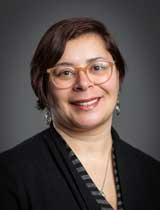 Dr. Gabriela Ramalho Tafoya discussed absolute poverty and possible solutions for it.
Dr. Gabriela Ramalho Tafoya discussed absolute poverty and possible solutions for it.
Photo provided by MU
‘Eradicating Extreme Poverty’ VIA Discusses Solutions
Brayden Scering
Assistant professor Dr. Gabriela Ramalho Tafoya and student Janette Olvera have compiled over 400 hours of research on conditional cash transfers in over 18 Latin American countries with the hope of educating students so that one day we can eradicate Latin American poverty someday. They shared this information in a VIA titled “Eradicating Extreme Poverty in Latin America” on Oct. 24 in Cordier Auditorium.
The VIA began with Tafoya when she asked the question “What is absolute poverty?” As she explained, absolute poverty is when a person or household does not have the minimum to meet their minimum standard of needs. This threshold was set by the United Nations to be considered under the label of absolute poverty one must make only $1.90 a day or less, or around $600 a year.
Tafoya explained that only a very few select countries would this amount of money allow someone to live comfortably. She continued with statistical analysis on countries in this threshold of poverty, one such country being the Democratic Republic of the Congo. In the Congo 77.10% of citizens or 66.8 million people live at this rate of poverty. In larger proportions her research shows that 12% or 730 million people in the world live at this rate of poverty.
She then explained how to solve this problem, sharing a little information about the welfare state and showing how the welfare state is much larger than what people think. The welfare state ranges anything from public education to social security to the federal loans that you took out to attend college.
Tafoya’s solution is through social policy. She explained the pros and cons to social policies, starting with how social policy works because it can reduce child poverty in most countries. She then discussed how social policies can be negative because they create a poverty trap, which is when you give an individual a little bit of money to help them and they begin to lose the ability to help themselves as well as taxation upon the rich can cause jobs to decrease hindering the economy. She offered some statistics that compare the amount of social assistance different countries give to their citizens and how their citizens are eligible for them. Finally, she explains the basics of conditional cash transfers and how they are good. They reduce poverty, develop human capital, and have conditionalities, Conditional cash transfers have three axes to them and that’s targeting (how to reach the poor), size (how much of the poor you reach), and conditionality (benefits and conditions needed).
Toward the end of the VIA Olvera took over to briefly go over her research and give some real-world examples by comparing two countries social assistance and looking at which country has the better assistance for their people. Olvera compared Chile and Mexico and throughout her research learned that Chile has better benefits and protections for their citizens.
At the end of the VIA Olvera was asked what she learned by doing this project and she said she learned how to further her knowledge on research articles, how much time goes into research, and how to improve her scientific writing skills.
Students learned a lot from this VIA. “I was able to learn how much countries are actively trying to combat poverty due to the decrease in the number of individuals in absolute poverty are down from one billion to around 700 million,” said Adam Bubelenyi.
Colleen Caylor says that she learned about the conditional cash transfers and how they are an intentional way to reduce poverty around the world.
Demark Bellman learned which continents and countries have the worst poverty rates and he said “I learned Africa was the worst,” he said.
These students all took away differing ideas from the VIA and hope to use this VIA to continue furthering their education and knowledge about poverty, especially in Latin America.